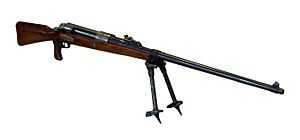Mauser 1918 T-Gewehr
| Mauser Mod. 1918 13.2 mm Tankgewehr | |
|---|---|
|
13.2 mm Rifle Anti-Tank at the Musée de l'Armée in Paris | |
| Type | Anti-tank rifle, Anti-materiel rifle |
| Place of origin |
|
| Service history | |
| In service | 1918–1933 |
| Used by |
|
| Wars |
World War I German Revolution of 1918–19 |
| Production history | |
| Manufacturer | Mauser |
| Produced | January 1918 |
| Number built | 15,800[1] |
| Variants |
M1918 shortened Magazine-fed[2] |
| Specifications | |
| Weight | 15.9 kg (35 lb), 18.5 kg (41 lb) loaded with the bipod |
| Length | 169.1 cm |
| Crew | two man crew |
|
| |
| Cartridge | 13.2 mm TuF (German: Tank und Flieger) |
| Caliber | 13.2 mm (.525 inches) |
| Action | bolt-action |
| Rate of fire | single shot |
| Effective firing range | 500 m |
| Feed system | manual |
| Sights | 100 – 500 m (notched V) |
The Mauser 13 mm anti-tank rifle (German: Tankgewehr M1918, usually abbreviated T-Gewehr[3][4]) was the world's first anti-tank rifle,[5] i.e. the first rifle designed for the sole purpose of destroying armored targets and the only anti-tank rifle to see service in World War I. Approximately 15,800 were produced.[6]
History
The British had first deployed tanks at the Battle of Flers–Courcelette in 1916 and they were followed by the French. It was a German weapon of World War I, appearing in February 1918. The Mauser Company began mass production at Oberndorf am Neckar in May 1918. The first of these off the production lines were issued to specially raised anti-tank detachments. The idea of using heavy calibre and high velocity rifles as anti-tank weapons originated in Germany. In June 1917, the German Army faced the menace of the Mark IV tank, and found that the armour-piercing 7.92 mm K bullet was no longer effective.
Operation
The rifle was a single shot bolt action rifle using the Mauser action, with rounds manually loaded into the chamber. The weapon had a pistol grip, bipod but no method of reducing the recoil such as a soft buttpad or muzzle brake. The iron sights were a front blade and tangent rear, graduated in 100 meter increments from 100 to 500 meters. The rifle was operated by a two-man crew of a gunner and ammunition bearer, who were both trained to fire the weapon.
Cartridge
The armour piercing hardened steel cored 13.2 x 92mm (.525-inch) semi-rimmed cartridge, often simply called "13 mm", was originally planned for a new, heavy Maxim MG.18 water-cooled machine gun, the Tank und Flieger (TuF) meaning for use against "tank and flier", which was under development and to be fielded in 1919. The rounds weighed 51.5 g (795 gn) with an initial velocity of 785 m/s (2,580 ft/s).[7] At 100 m an armour plate 22 mm thick could be pierced.
Surviving examples
The anti-tank rifle can be found in several museums:
- Argentina
- Museo de Armas, Circulo Militar, Buenos Aires
- Australia
- Belgium
- Canada
- On display in the lobby of the McGill club, Montreal, being the gift made in 1919 by a Canadian general
- The Officers and Non-Commissioned Officers (ONCO) Mess of the South Alberta Light Horse in Medicine Hat, Alberta
- France
- The Musée de l'Armée at the Invalides, Paris
- Germany
- UK
- Imperial War Museum, London
- King's Own Royal Border Regiment museum
- 22nd Cheshire Regiment museum
- Royal Armouries Museum in Leeds
- Norwich Castle Museum, Norwich
- Redoubt Fortress and Museum, Eastbourne
- King's Shropshire Light Infantry museum, Shrewsbury castle
- Norris Museum, St Ives, Huntingdonshire
- USA
- Patton Museum, Fort Knox
- The National World War I Museum and Liberty Memorial in Kansas City, Missouri
- NRA National Firearms Museum in Fairfax, VA
- Woodrow Wilson Presidential Library, Staunton, VA
- Latvia
See also
.
References
- ↑ "Blood and Iron". Retrieved 10 October 2014.
- ↑ Robert Ball (2011). Mauser Military Rifles of the World, 5th Edition. Gun Digest Books. p. 193. ISBN 1-4402-1544-8.
- ↑ Ball, Robert M. (2006). Mauser Military Rifles of the World (Mauser Military Rifles of the World). Gun Digest Books. p. 183. ISBN 0-89689-296-4.
- ↑ Stephen Bull (2004). Encyclopedia of military technology and innovation. p. 15. ISBN 978-1-57356-557-8.
- ↑ "WW1 Anti-Tank rifles". Retrieved 10 October 2014.
- ↑ "Blood and Iron". Retrieved 10 October 2014.
- ↑ Johnson, Melvin M., Jr. (1944). Rifles and Machine Guns. New York: William Morrow & Company. p. 384.
External links
| Wikimedia Commons has media related to 13.2 mm Rifle Anti-Tank (Mauser). |
| ||||||||||
